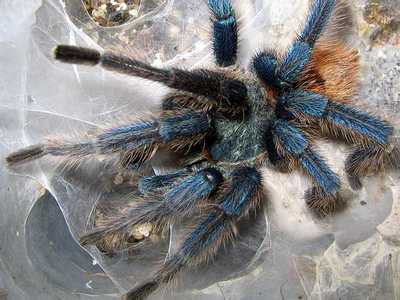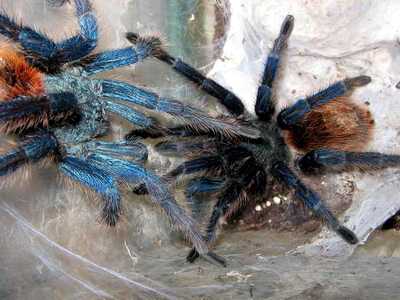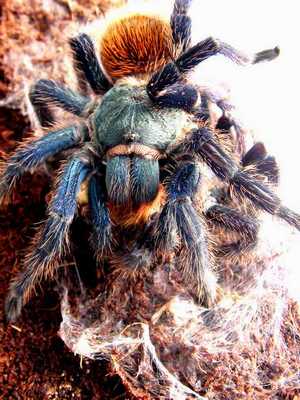Chromatopelma
Genus Chromatopelma Schmidt, 1995
Genus status. The genus was established for Avicularia cyaneopubescens (Strand, 1907) by G. Schmidt in 1995. Also earlier was referred to Eurypelma (by Strand, 1907) and Delopelma (by Petrunkevich, 1939).
Type species - Avicularia cyaneopubescens (Strand, 1907).
Monotypical genus, presented by the single species - Chromatopelma cyaneopubescens, being a decoration of any collection! The combination of orange coloration of abdomen, blue legs and bottlegreen colour of carapace, together with very slight aggressiveness and disliking to hide does its the desired object for any collector.
 At present time from southamerican zootrade companies there`re specimens of species supposedly referring to new species of this genus but any systematic data and features for it is not defined.
At present time from southamerican zootrade companies there`re specimens of species supposedly referring to new species of this genus but any systematic data and features for it is not defined.
Characterized by presence of type IV urticating hairs, spermathecae shape, which is similar to the representatives of genus Brachypelma Simon, 1890. Differs from most close in systematic features genus Cyriocosmus Simon, 1903 by absence of branch on male embolus. Scopulation of metatarsus and tarsus of leg IV not divided, tarsus of leg III longitudally finely divided. Tibial spurs of a male presented.
Females reach 7 cm of body lengh and 15 cm in legspan, males - about 10-12 cm in legspan.
Longevity in captivity: males - 2-3 years, females - over 12 years.
 Newborn spiderling are of the some big size compairing to most the theraphosine tarantulas and has specific overall coloration, reaches about 12 mm in legspan, grow enough quickly and became mature to 1,5-2,5 years depending on keeping temperature conditions and intensities of feeding.
Newborn spiderling are of the some big size compairing to most the theraphosine tarantulas and has specific overall coloration, reaches about 12 mm in legspan, grow enough quickly and became mature to 1,5-2,5 years depending on keeping temperature conditions and intensities of feeding.
Mature male has the same coloration as the female (no sexual dimorphism).
Keeping conditions. For the first time Chromatopelma cyaneopubescens was imported in USA in 1993 and was on sale on price not less $250 USD for adult specimen.
Together with that, in connection with prohibition by Venezuelan legislation it is not exported for last years.
 Only several cases of breeding this particular species are documented (Bagaturov M., 2007). Females are known as the most cruel among tarantulas of the World fauna regarding the male killing tendency, sometimes even intead of mating with them. In absolutly most cases You'll have to left a male in femele's enclosure because the mating can takes hours and hours after introducing a male, so You can never knew does a mating has occure or not... After all, the fact of successful mating do not guarantee a production of an eggsac. To breed this species in captivity, You'll have to artificially simulate a seasonal changes as it takes place in nature mostly providing raising of the humidity for mature male and female before mating attempts.
Only several cases of breeding this particular species are documented (Bagaturov M., 2007). Females are known as the most cruel among tarantulas of the World fauna regarding the male killing tendency, sometimes even intead of mating with them. In absolutly most cases You'll have to left a male in femele's enclosure because the mating can takes hours and hours after introducing a male, so You can never knew does a mating has occure or not... After all, the fact of successful mating do not guarantee a production of an eggsac. To breed this species in captivity, You'll have to artificially simulate a seasonal changes as it takes place in nature mostly providing raising of the humidity for mature male and female before mating attempts.
A cocoon of this species on average consists of 90-170 eggs (Bagaturov; Towler, 2007).
One of the main conditions of successful keeping for this species, in contarary with the conditions which should be mainteined for stimulation of breeding this beautiful tarantula, is a low humidity in terrarium. Overmoistening of the substrate can cause a death of sub-adult and adult spiders. However for newborn slings of the first several ages substratum must be kept in mildly moistened condition on one side of the container.
It is reasonable to keep this tarantula in vertical or cubic terrariums.
Spiders of earlier ages can burrow if given enough layer of substatum. Can stand short temperature lowering to 15°C.
Distribution: In nature Chromatopelma cyaneopubescens inhabiting the bottomland of Paraguara River, Falcon state, Venezuela, occupying xeric sites of bush and woods where lives in superficial holes or web-plaited hammock-type retreats on the base of prickly undersized bushes.
|
Species |
Common name |
Areal |
Photo |
Biology |
Keeping conditions |
|
cyaneopubescens (Strand, 1907) |
Greenbottle blue tarantula |
Venezuela |
Photo Anton Labunsky© 2003 Фото Ian Metcalfe© 2004 |
The only one unpleasant feature of this spider - it`s flick urticating hairs being disturbing. |
It is kept under low humidity about 40-60% on mildly moistened or completely dry substratum, and temperature 23-27°С. |


